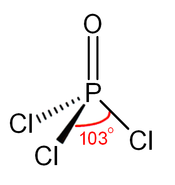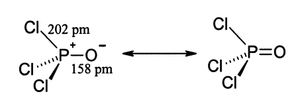Phosphoryl chloride

| |||
| |||

| |||
| Names | |||
|---|---|---|---|
| IUPAC names
Phosphoryl trichloride
Phosphorus trichloride oxide | |||
| Other names
Phosphorus oxychloride
Phosphoric trichloride Trichlorophosphate | |||
| Identifiers | |||
3D model (JSmol)
|
|||
| ChEBI | |||
| ChemSpider | |||
| ECHA InfoCard | 100.030.030 | ||
| EC Number |
| ||
PubChem CID
|
|||
| RTECS number |
| ||
| UNII | |||
| UN number | 1810 | ||
CompTox Dashboard (EPA)
|
|||
| |||
| |||
| Properties | |||
| POCl3 | |||
| Molar mass | 153.33 g/mol | ||
| Appearance | Clear, colourless liquid, fumes in moist air | ||
| Odor | pungent and musty | ||
| Density | 1.645 g/cm3, liquid | ||
| Melting point | 1.25 °C (34.25 °F; 274.40 K) | ||
| Boiling point | 105.8 °C (222.4 °F; 378.9 K) | ||
| Reacts | |||
| Vapor pressure | 40 mmHg (27°C)[1] | ||
| Structure | |||
| tetrahedral | |||
| 2.54 D | |||
| Hazards | |||
| NFPA 704 (fire diamond) | |||
| NIOSH (US health exposure limits): | |||
PEL (Permissible)
|
none[1] | ||
REL (Recommended)
|
TWA 0.1 ppm (0.6 mg/m3) ST 0.5 ppm (3 mg/m3)[1] | ||
IDLH (Immediate danger)
|
N.D.[1] | ||
| Safety data sheet (SDS) | ICSC 0190 | ||
| Related compounds | |||
Related compounds
|
Thiophosphoryl chloride Phosphorus oxybromide Phosphorus trichloride Phosphorus pentachloride | ||
| Supplementary data page | |||
| Phosphoryl chloride (data page) | |||
Except where otherwise noted, data are given for materials in their standard state (at 25 °C [77 °F], 100 kPa).
| |||
Phosphoryl chloride (commonly called phosphorus oxychloride) is a colourless liquid with the formula Template:PhosphorusTemplate:OxygenTemplate:Chlorine3. It hydrolyses in moist air releasing phosphoric acid and choking fumes of hydrogen chloride. It is manufactured industrially on a large scale from phosphorus trichloride and oxygen or phosphorus pentoxide. It is mainly used to make phosphate esters such as tricresyl phosphate.
Structure
Like phosphate, phosphoryl chloride is tetrahedral in shape. It features three P-Cl bonds and one strong P=O double bond, with an estimated bond dissociation energy of 533.5 kJ/mol. On the basis of bond length and electronegativity, the Schomaker-Stevenson rule suggests that the double bond form is very dominant (in contrast with POF3). The P=O bond does not utilize the d-orbitals on phosphorus as is commonly described in older textbooks as quantum chemical calculations have shown that d-orbitals are not involved in main group chemical bonding (see Hypervalent molecule). More modern texts favour a description which involves the donation of the lone pair electrons from oxygen p-orbitals to the antibonding phosphorus-chlorine bonds thus constituting π bonding.[2]
- where pm = picometers
Physical properties
With the freezing point of 1 °C and boiling point 106 °C, the liquid range is rather similar to water.
Chemical properties
POCl3 reacts with water and alcohols to give hydrogen chloride and phosphoric acid or phosphate esters, respectively:
- O=PCl3 + 3 H2O → O=P(OH)3 + 3 HCl
If the water is replaced by an alcohol, the trialkyl phosphate esters result. Such reactions are often performed in the presence of an HCl acceptor such as pyridine or an amine. If POCl3 is heated with an excess of a phenol (ArOH) in the presence of a Lewis acid catalyst such as magnesium chloride, a triaryl phosphate ester such as triphenyl phosphate is formed. For example:
- 3 C6H5OH + O=PCl3 → O=P(OC6H5)3 + 3 HCl
POCl3 can also act as a Lewis base, forming adducts with a variety of Lewis acids such as titanium tetrachloride:
- Cl3P+-O− + TiCl4 → Cl3P+-O−-TiCl4
The aluminium chloride adduct (POCl3·AlCl3) is quite stable, and so POCl3 can be used to remove AlCl3 completely from reaction mixtures at the end of a Friedel-Crafts reaction. POCl3 reacts with hydrogen bromide in the presence of AlCl3 to produce POBr3.
Preparation
Phosphoryl chloride can be prepared by various methods, notable examples include:
- The reaction of phosphorus trichloride with oxygen at 20–50 °C (air is ineffective):
- 2 PCl3 + O2 → 2 POCl3
- The reaction of phosphorus pentachloride (PCl
5) with phosphorus pentoxide (P
4O
10). The reaction can be simplified by chlorinating a mixture of PCl3 and P4O10, generating the PCl5 in situ. As the PCl3 is consumed, the POCl3 products become a solvent for the unreacted solid starting reagents:[citation needed]
- 6 PCl3 + 6 Cl2 → 6 PCl5
- 6 PCl5 + P4O10 → 10 POCl3
- The reaction of phosphorus pentachloride with boric acid or oxalic acid:[3]
- The oxidation of phosphorus trichloride with potassium chlorate:[3]
- 3 PCl3 + KClO3 → 3 POCl3 + KCl
- The reaction of phosphorus pentoxide with sodium chloride:[4]
- 2 P2O5 + 3 NaCl → 3 NaPO3 + POCl3.
- Reduction of tricalcium phosphate with carbon in the presence of chlorine gas:[4]
Uses
The most important use for phosphoryl chloride is in the manufacture of triarylphosphate esters (as described above) such as triphenyl phosphate and tricresyl phosphate. These esters have been used for many years as flame retardants and plasticisers for PVC. Meanwhile, trialkyl esters such as tributyl phosphate (made similarly from butan-1-ol) are used as liquid-liquid extraction solvents in nuclear reprocessing and elsewhere.
In the semiconductor industry, POCl3 is used as a safe liquid phosphorus source in diffusion processes. The phosphorus acts as a dopant used to create N-type layers on a silicon wafer.
In the laboratory, POCl3 is widely used as a dehydrating agent, for example the conversion of primary amides to nitriles. Similarly, certain aryl amides can be cyclised to dihydroisoquinoline derivatives using the Bischler-Napieralski reaction.
Such reactions are believed to go via an imidoyl chloride; in certain cases where it is stable, the imidoyl chloride is the final product. For example, pyridones and pyrimidones can be converted to chloro- derivatives of pyridines and pyrimidines, which are important intermediates in the pharmaceutical industry.[5]
Another common laboratory use for POCl3 is in the Vilsmeier-Haack reaction, where it reacts with amides to produce a "Vilsmeier reagent," a chloro-iminium salt, which subsequently reacts with electron-rich aromatic compounds to produce aromatic aldehydes upon aqueous work-up.[6]
References
- ^ a b c d NIOSH Pocket Guide to Chemical Hazards. "#0508". National Institute for Occupational Safety and Health (NIOSH).
- ^ D. B. Chesnut (1999). "The Electron Localization Function (ELF) Description of the PO Bond in Phosphine Oxide". Journal of the American Chemical Society. 121 (10): 2335–2336. doi:10.1021/ja984314m.
- ^ a b Pradyot, Patnaik (2003). Handbook of Inorganic Chemicals. New York: McGraw-Hill. p. 709. ISBN 0070494398.
- ^ a b Lerner, Leonid (2011). Small-Scale Synthesis of Laboratory Reagents with Reaction Modeling. Broken Sound Parkway, NW: CRC Press. pp. 169–177. ISBN 9781439813126.
- ^ R. C. Elderfield, Heterocyclic Compounds, Vol. 6, p 265
- ^ Charles D. Hurd and Carl N. Webb (1925). "p-Dimethylaminobenzophenone". Organic Syntheses; Collected Volumes, vol. 1, p. 217.
Further reading
- N. N. Greenwood, A. Earnshaw, Chemistry of the Elements, 2nd ed., Butterworth-Heinemann, Oxford, UK, 1997.
- Handbook of Chemistry and Physics, 71st edition, CRC Press, Ann Arbor, Michigan, 1990.
- J. March, Advanced Organic Chemistry, 4th ed., p. 723, Wiley, New York, 1992.
- The Merck Index, 7th edition, Merck & Co, Rahway, New Jersey, USA, 1960.
- A. D. F. Toy, The Chemistry of Phosphorus, Pergamon Press, Oxford, UK, 1973.
- L. G. Wade, Jr., Organic Chemistry, 6th ed., p. 477, Pearson/Prentice Hall, Upper Saddle River, New Jersey, USA, 2005.
- B. J. Walker, Organophosphorus chemistry, p101-116, Penguin, Harmondsworth, UK, 1972.
- CDC - NIOSH Pocket Guide to Chemical Hazards





